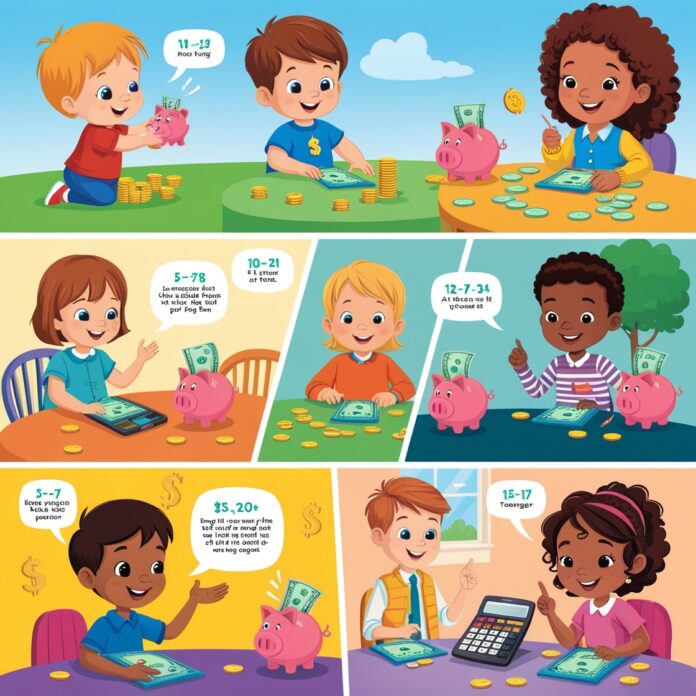Teaching kids about money is one of the most valuable life skills a parent or educator can impart. Financial literacy for kids is not just about understanding coins and bills—it’s about helping them build a solid foundation for money management that will serve them for the rest of their lives. This age-by-age money guide offers practical tips on teaching children money concepts that align with their developmental stage, ensuring that financial education for children is both effective and engaging.

Why Teaching Kids About Money Matters
In today’s fast-paced world, financial education for young kids has become more important than ever. Kids need to learn how to save, spend, budget, and understand the value of money. Early money lessons for kids can prevent poor financial habits as they grow older. Parents who engage in teaching kids financial skills are laying the groundwork for a financially responsible future.
Money Skills for Different Ages: A Breakdown
Ages 3-5: Basic Money Concepts
At this stage, children are learning about the world around them, including basic concepts such as colors, shapes, and sizes. Teaching kids about money begins with simple ideas like identifying coins and bills. Here’s how to introduce money:

-
Introduce Coins and Bills: Show your child different types of coins and bills and talk about their names, sizes, and values. Use toy money or real coins to help them understand the difference between pennies, nickels, dimes, and quarters.
-
Play Store: Set up a pretend store where your child can “buy” items using their coins. This teaches them the idea of exchanging money for goods.
-
Teach Simple Saving: Give your child a piggy bank and explain that saving money means putting some away for later. You could use a simple visual, like jars for “save,” “spend,” and “share.”
By the age of 5, children are likely to grasp the idea that money is used to buy things and that not all things are free.
Ages 6-9: Understanding Value and Making Choices
As children grow, they begin to develop a deeper understanding of money’s value and the concept of budgeting. Here’s how to approach teaching kids money management during these years:

-
Introduce Allowances: Give your child a weekly allowance. This is a great opportunity to teach them how to manage money, and it offers them the chance to make decisions about spending, saving, and sharing.
-
Use Money Lessons for Kids: Teach your child how to make choices about their money. For example, if they want a toy, explain that they need to save for it by putting aside part of their allowance.
-
Discuss Needs vs. Wants: Teach your child the difference between needs (things like food, shelter, and clothing) and wants (toys, video games). Help them make decisions based on these concepts.
-
Savings Goals: Start small savings goals, such as saving for a toy or an outing. This will help them learn about delayed gratification.
By now, your child should understand that money is limited, and how they use it matters. This is a good time to start teaching them about setting money aside for different goals.
Ages 10-13: Learning to Budget and Save
This is the age when kids can start understanding the importance of budgeting. Their money skills will grow as they learn to prioritize their spending. Here’s how to continue teaching kids financial education during these years:

-
Set Up a Budget: Teach your child how to make a simple budget by allocating money to savings, spending, and giving. Use their allowance or a small income from chores to teach them how to divide money into these categories.
-
Teach Financial Goals: Talk about long-term savings goals, such as saving for a big-ticket item like a bike, a gaming console, or a special trip.
-
Introduce Banking: Consider opening a basic savings account for your child at a bank. This introduces them to the idea of earning interest and keeping money in a safe place.
-
Discuss Credit: Explain the concept of credit and borrowing in simple terms. Discuss how using credit cards works and how it can be both useful and dangerous if not managed properly.
At this age, kids should be able to make more complex financial decisions and should start practicing responsible money management.
Ages 14-17: Mastering Money Management and Financial Independence
Teenagers are ready to take on more responsibility when it comes to managing money. They may have part-time jobs, and they are starting to develop their financial independence. Teaching them about money at this stage involves deepening their understanding of saving, investing, and earning:

-
Introduce Financial Tools: Teach your teenager about financial tools like debit cards, online banking, and budgeting apps. Help them understand how to track their spending and set financial goals.
-
Discuss Investments: Explain the basics of investing, whether in stocks, bonds, or other assets. While they may not be ready to invest yet, understanding how investments work is an important part of financial education for young kids.
-
Teach About Taxes: As they start to earn their own money, it’s important to introduce the concept of taxes. Explain how taxes are deducted from their earnings and why they are important for public services.
-
Help Set Up a Savings Plan: Encourage your teen to save a percentage of their income for long-term goals, such as college or a car. Discuss the importance of building wealth over time.
This is the stage where teenagers should develop an understanding of financial responsibility and independence. They are beginning to make significant financial decisions, and the foundation you lay here will carry them into adulthood.
How to Teach Kids Financial Skills: The Best Way to Teach
When teaching children money concepts, consistency and practical experience are key. Here are a few strategies to make the learning process easier and more engaging:
-
Lead by Example: Children learn a lot by observing their parents‘ behavior. Demonstrate good financial habits like saving, budgeting, and spending responsibly.
-
Make Learning Fun: Use games, apps, and activities that teach money skills in a fun way. There are many educational games that simulate money management and help kids practice budgeting.
-
Be Patient: Financial literacy for kids takes time. They may not always grasp concepts right away, but with consistent practice, they will eventually learn.
Money Tips for Kids by Age: Summary of Key Concepts
-
Ages 3-5: Start with the basics—coins, bills, and the idea of saving.
-
Ages 6-9: Introduce allowances, budgeting, and needs vs. wants.
-
Ages 10-13: Teach budgeting, savings goals, and introduce banking.
-
Ages 14-17: Teach about investing, taxes, and financial independence.
Teaching children about money is a vital skill that will serve them well into adulthood. By introducing age-appropriate concepts and offering opportunities to practice, parents can ensure that their children develop strong financial skills. From basic coin identification to managing a budget and investing, the earlier kids start learning, the better prepared they will be for financial independence.



